Glossary of botanical terms
This article needs additional citations for verification. (December 2022) |
This glossary of botanical terms is a list of definitions of terms and concepts relevant to botany and plants in general. Terms of plant morphology are included here as well as at the more specific Glossary of plant morphology and Glossary of leaf morphology. For other related terms, see Glossary of phytopathology, Glossary of lichen terms, and List of Latin and Greek words commonly used in systematic names.
A
[edit]- ab-
- Prefix meaning "position away from".[1]
- abaxial
- Surface of an organ facing away from the organ's axis, e.g. the lower surface of a lateral organ such as a leaf or petal.[2] Contrast adaxial.
- abort
- To abandon development of a structure or organ.[3]
- abscission
- Natural shedding of an organ that is mature or aged, as of a ripe fruit or an old leaf.[4]
- abscission zone
- Specialized layer of tissue that allows an organ to be shed by abscission when it is ripe or senescent. Such tissue is commonly formed, for example, at the base of a petiole or pedicel.
- acaulescent
- Having no apparent stem, or at least none visible above the ground surface.[2] Examples include some species of Oxalis,[5] Nolina,[6] and Yucca.[7] Antonym: caulescent (possessing stem).
- accrescent
- Increasing in size with age, such as a calyx that continues to grow after the corolla has fallen,[2] e.g. in Physalis peruviana.
- accumbent
- Lying against another part of the plant; when applied to a cotyledon, it means that an edge of the cotyledon lies along the folded radicle in the seed.[8]
- -aceae
- Suffix added to the word stem of a generic name to form the name of a taxonomic family;[9] for example, Rosaceae is the rose family, of which the type genus is Rosa.[10]
- achene
- Dry, one-seeded indehiscent fruit[11] in which the true fruit is not the so-called "berry", but the achenes, which are the so-called "seeds" on the infructescence, e.g. in the genus Fragaria.
- acicular
- Slender or needle-shaped.[11] See also Leaf shape.
- acropetal
- Moving from roots to leaves, e.g. of molecular signals in plants.
- acrophyll
- Regular leaves of a mature plant, produced above the base, as opposed to bathyphyll.
- acrostichoid
- (describing a type of sorus) Covering the entire abaxial surface of a frond, usually densely so, as in Elaphoglossum and Acrostichum.
- actino-
- Prefix that indicates a radial pattern, form, or morphology.
- actinodromous
- (of leaf venation) Palmate or radially arranged venation with three or more primary veins arising at or near the base of the leaf and reaching the margin in most species, but not all.
- actinomorphic
- Regular or radially symmetrical;[12] may be bisected into similar halves in at least two planes. Applies e.g. to steles and flowers in which the perianth segments within each whorl are alike in size and shape. Compare regular. Contrast asymmetrical, irregular, and zygomorphic.
- aculeate
- Armed with prickles,[13] e.g. the stem of a rose.
- acumen
- A long, tapering point, especially the apex of an acuminate leaf.
- acuminate
- Tapering gradually to a point, with concave sides approaching the point.[13] Contrast acute and mucronate. See also Leaf shape.
- acute
- 1. Sharply pointed, but not drawn out, with straight sides approaching the point.[13] Contrast acuminate. See also Leaf shape.
- 2. Converging at an angle of less than 90°. Contrast obtuse.
- ad-
- Prefix meaning "near or toward"; also meaning "added to".[13]
- adaxial
- Surface of an organ facing toward the organ's axis,[13] e.g. the upper surface of a lateral organ such as a leaf or petal. Contrast abaxial.
- adelphia
A bundle or structure of stamens forming one unit in an adelphous flower; for example, the stamen tube around the pistil of Hibiscus.
- adelphous
- Having organs, particularly filaments such as stamens, connected into one or more adelphiae, whether in the form of bunches or tubes, such as is commonly seen in families such as Malvaceae. Usage of the term is not consistent; some authors include closely bunched filaments, while others include only adelphiae in which filaments are connected minimally at their bases. See, for example, Sims: "...the filaments are so closely pressed that they have the appearance of being monadelphous...".[14] Compare derived terms such as monadelphous, having stamens growing in a single bunch or tube, for example in Hibiscus, and diadelphous, growing in two bunches.
- adherent
- Slightly united to an organ of another kind,[13] usually to a part of another whorl, e.g. a sepal connected to a petal. Contrast adnate.
- adnate
- Grown from or closely fused to an organ of a different kind,[13] especially along a margin, e.g. a stamen fused to a petal. Adnate anthers have their halves attached to the filament through most of their length. Contrast connate.
- adventitious
- Produced in an unpredictable or unusual position,[13] e.g. an adventitious bud produced from a stem rather than from the more typical axil of a leaf. Adventitious roots may develop from nodes of prostrate stems of some plant species, or from the hypocotyl rather than from the radicle of a germinating monocotyledon.
- adventive
- Introduced accidentally[13] (usually referring to a weed).
- aerial
- Of the air; growing or borne above the surface of the ground or water.[15]
- aestivation
- Arrangement of sepals and petals or their lobes in an unexpanded flower bud. Contrast vernation.
- aff. (affinis)
- With affinity to others, akin to; often used for a provisionally recognized but unnamed taxon considered close to that name, perhaps a hybrid or extreme variant.
- aggregate fruit
- Cluster of fruits formed from the free carpels of a single flower, e.g. a blackberry. Compare multiple fruit.
- agochoric
- Plants that are spread through accidental transport.
- agricultural weed
- See weed.
- agriophyte
- Plant species that have invaded native vegetation and could survive there without human intervention. They are established there in natural habitats, remaining part of natural vegetation even after human influence has ceased, and are independent of humans in their continued existence.[16]
- agrophic
- Comb-like series of veins forking from a single side of a primary or secondary vein.
- agrostology
- The scientific study of grasses, in the strictest sense only those species which are members of the family Poaceae. Broader usages sometimes also include grass-like or graminoid species from the families Cyperaceae, Juncaceae, and Typhaceae.
- alate
- Having a wing or wings.
- albumen
- Older name for the endosperm of flowering plants. Except for being a storage tissue for nutrients, it is not like the albumen (egg white) of animal embryos.
- albuminous
- (of seeds) Containing endosperm.
- -ales
- Suffix added to the stem of a generic name or descriptive name to form the name of a taxonomic order.
- alien
- Any plant introduced to an area outside its natural range. Often used interchangeably or in combination with foreign, exotic, non-native, and non-indigenous.
- alkaloid
- Any of a loosely defined class of organic compounds found in the tissues of many species of plants. Alkaloid molecules have one or more alkaline-reacting nitrogen atoms in their carbon structures. Many alkaloids are commercially important as drugs or poisons, e.g. caffeine, morphine, quinine, and strychnine, each of which occurs naturally in certain plants.
- allelopathy
- The secretion by a plant of biochemicals which influence the growth and reproduction of nearby plants.
- allopatric
- Having geographically separate, non-overlapping ranges of distribution.[17] Contrast sympatric.
- alternate
- 1. (adj.) (of leaves or flowers) Borne singly at different levels along a stem, including spiralled parts. Contrast opposite.
- 2. (prep.) Occurring between something else, e.g. stamens alternating with petals.
- alternipetalous
- A configuration where parts of the flower, e.g. stamens, alternate in position with the petals.[18]
- ament
- A synonym of catkin.
- amphitropous
- (of an ovule) Bent so that both ends are near each other. Contrast anatropous, campylotropous, and orthotropous.
- amplexicaul
- With the base dilated and clasping the stem, usually of leaves.
- amylum star
- a vegetative propagative body filled with starch (amylum) and located around the lower nodes of certain stoneworts.
- anastomose
- Branching and then rejoining, as with leaf venation.
- anastomosis
- A connection or fusion of two or more veins that are normally diverging or branching, thereby forming a network.
- anatropous
- (of an ovule) Inverted so that the micropyle faces the placenta (this is the most common ovule orientation in flowering plants). Contrast amphitropous, campylotropous, and orthotropous.
- ancipital
- Flat, with two edges (versus round).[19]
- androdioecious
- Having bisexual flowers and male flowers on separate individuals. Contrast andromonoecious, polygamodioecious, polygamomonoecious, and polygamous.
- androecium
- A collective name for the male reproductive parts of a flower; the stamens of a flower considered collectively. Contrast gynoecium. Abbreviated A; e.g. A 3+3 indicates six stamens in two whorls.
- androgynophore
- A stalk bearing both the androecium and gynoecium of a flower above the level of insertion of the perianth.
- androgynous
- Having male and female flowers in the same inflorescence.
- androphore
- The stalk or column supporting the stamens in certain flowers.
- andromonoecious
- Having bisexual flowers and male flowers on the same individual plant. Contrast androdioecious, gynomonoecious, polygamodioecious, polygamomonoecious, and polygamous.
- anemophilous
- Adapted to pollination by wind.
- anemophily
- Adaptation to pollination by wind.
- angiosperm
- A flowering plant; a plant with developing seeds enclosed in an ovary.
- anisomery
- The condition of having a floral whorl with a different (usually smaller) number of parts from the other floral whorls.
- anisotomic
- Branching, with branches having unequal diameters, such as a trunk and its branch. Contrast isotomic.
- annual
- A plant that completes its life cycle (i.e. germinates, reproduces, and dies) within a single year or growing season.
- annulus
- 1. A ring-like structure; in the form of a ring. Pappus bristles are sometimes attached to a ring called an annulus or disk at the top of the achene beak. In some pollen grains, the exine around the apertures is either thicker or thinner. In pores, this border is termed an annulus. Certain flowers have ring-like constrictions at the mouth of the flower, e.g. in Huernia and Aristolochia.
- 2. A ring of specialized cells on the sporangium.
- anterior
- Positioned in front of, toward the apex. Compare distal.
- anthemoid
- In the Compositae, a style with a brush-like tuft of sweeping hairs at the tip of each style branch.
- anther
- The pollen-bearing part of a stamen.
- antheridium
- in bryophytes, a specialized gametophytic organ that produces the male gametes.
- antheridiophore
- In liverworts of the order Marchantiales, a male gametophore, a specialized, stalked structure that bears the antheridia.
- antherode
- A sterile anther of a staminode.
- anthesis
- 1. (of a flower) The period during which pollen is presented and/or the stigma is receptive.
- 2. (of a flowering plant) The period during which flowers in anthesis are present. Not defined for some cases, such as when pollen is released in the bud.
- anthocarp
- A type of fruit in which some part of the flower persists attached to the pericarp, e.g. in Nyctaginaceae.
- anthophore
- A stalk-like structure, internode located between the calyx and the other parts of the flower.
- anticlinal
- Pointing up, away from, or perpendicular to a surface. Contrast periclinal.
- antrorse
- Directed forward or upward, e.g. of hairs on a stem. Contrast retrorse.
- apetalous
- Lacking petals.
- apex
The tip; the point furthest from the point of attachment.
- aphananthous
- (of flowers) Inconspicuous or unshowy, as opposed to phaneranthous or showy.
- aphlebia
Imperfect or irregular leaf endings commonly found on ferns and fossils of ferns from the Carboniferous Period.
- aphyllous
- Leafless; having no leaves.[20]
- apical
- At or on the apex of a structure, usually a shoot, a stem, or the trunk of a tree, e.g. an apical meristem or an apical bud.
- apiculate
- especially of leaves, ending in a short triangular point. See also Leaf shape.
- apiphily
- A form of pollination whereby pollen is distributed by honey bees.
- apo-
- A prefix meaning "away from, separate, without".
- apocarpous
- (of a gynoecium) Consisting of one or more carpels which are free from one another (or almost so), e.g. in members of the Ranunculaceae and Dilleniaceae.
- apomixis
A type of asexual reproduction whereby viable seeds or spores are produced asexually, without fertilization, such that the genetic material they contain is a clone of the parent's genetic material. A plant produced in this way is called an apomict.
- apomorphy
- In cladistics, a "different form" from the form of an ancestor (i.e., an innovation) of use in determining membership in a clade.
- apopetalous
- Having separate petals, not fused (sympetalous).
- apophyllous
- Perianth or other segments free, not united. Compare symphyllous, gamophyllous, and polyphyllous.
- apophysis
- 1. The external part of a cone scale.
- 2. An outgrowth of an organ or an enlargement of a stem.
- appendage
- A secondary part attached to a main structure; an external growth that seldom has any obvious function, hence appendiculate.
- appendiculate
- Having the nature of or bearing appendages.
- appressed
- Pressed closely but not fused, e.g. leaves against a stem.
- aquatic plant
- A plant whose natural habitat is water, living in or on water for all or a substantial part of its lifespan; generally restricted to fresh or inland waters.
- arachnoid
- Cobwebby, from being covered with fine white hairs.
- arborescent
- Tree-like in growth or general appearance.
- arboretum
A taxonomically arranged collection of trees.
- archaeophyte
- A non-native plant that has nonetheless been present in a particular geographic area for some time. Contrast neophyte.
- archegonium
- A multicellular haploid structure or organ of the gametophyte phase of certain plants, producing and containing the ovum or female gamete. The corresponding male organ is called the antheridium.
- archegoniophore
- In liverworts of the order Marchantiales, a female gametophore: a specialized, stalked structure that bears the archegonia and the sporophytes.
- arctotoid
- In the Compositae, a style with a ring of sweeping hairs borne on the shaft of the style proximal to the style branches.
- areolate
- Having or being composed of areoles, as an areolate crustose lichen.
- areole
- 1. A space between the threads of a net, e.g. that part of a leaf surface defined by each of the elements of a vein network; as with cacti, the area between the veinlets of a leaf.
- 2. A structure on the stem node of a cactus, morphologically a specialised branch; the region of a cactus upon which spines, glochids, and flowers are borne.
- aril
- A membranous or fleshy appendage formed by expansion of the funicle which partly or wholly covers a seed, e.g. the fleshy outer layer of lychee fruit, or that found in members of the Sapindaceae.
- aristate
- With a stiff, bristle-like awn or tip. See also Leaf shape.
- article
- A segment of a jointed stem or of a fruit with constrictions between the seeds; an organ part that separates easily from the rest of the organ at a joint or articulation.
- articulate
- Jointed; separating freely, leaving a clean scar; e.g. the fronds of certain ferns where they join the rhizome.
- ascending
- 1. (of a stem) Spreading horizontally, then directed upward; an ascending stem is more or less prostrate near its base, then erect.
- 2. (of an ovule) Attached somewhat above the base.
- ascidiate
- Shaped like a pitcher, as with the leaves of pitcher plants, e.g. species of Nepenthes and Sarracenia.[21]
- asexual reproduction
- Reproduction that does not involve gametes. Often used interchangeably with vegetative reproduction.
- asperulous
- Having a rough, sandpapery texture; e.g. some leaf surfaces.
- asymmetrical
- Irregular or unequal; lacking any plane of symmetry; e.g. flowers of Canna.
- attenuate
- Narrowing gradually. See also Leaf shape.
- auricle
- An ear-shaped lobe, particularly a small, roundish, lateral appendage of a leaf or leaf-like organ.
- auriculate
- Attached at the base with ear-shaped appendages (auricles). See also Leaf shape.
- autogamous
- Self-pollinating, self-fertilizing – in flowering plants
- awn
- 1. Any long, bristle-like appendage.
- 2. In the Poaceae, an appendage terminating or on the back of glumes or lemmas of some grass spikelets.
- 3. In the Geraniaceae, the part of the style that remains attached to the carpel that separates from the carpophore (column).
- 4. A generally straight, stiff pappus element, varying from stiffly bristle-like to hard and needle-like. In Strophanthus, the awn is the beak of the seed, stipe of the coma hairs.
- axil
- The upper angle between one part of a plant and another, e.g. the stem and a leaf.
- axile
- On an axis; of a placenta, on the central axis of the ovary.
- axillary
- Borne in or arising from the axil, usually referring to the axil of a leaf.
- axis
- The main stem of a whole plant or inflorescence; also, the line along which this stem extends.

In the bud, Tetradenia riparia leaves have their upper surfaces turned toward the stem and the axil. The lower surface is abaxial ("away from the axis"), and the upper surface is adaxial.


Welwitschia mirabilis presents an example of an acaulescent growth habit unusual in so large a plant species.

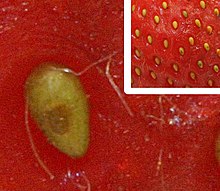
Achenes on the surface of the stem of the infructescence of a strawberry
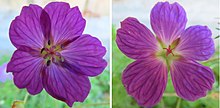
Geranium incanum flowers are actinomorphic, having five axes of symmetry, as opposed to the two axes of symmetry of the zygomorphic flowers of most species of the related genus Pelargonium.

Fern frond with acuminate leaflets
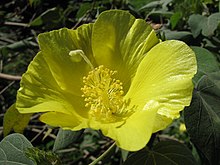
Adelphous stamens in flower of Gossypium tomentosum


Diagram of a coconut fruit. The albumen (endosperm) is labelled Alb.
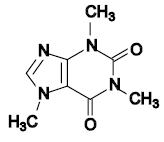

Rothmannia leaf with extensively anastomose venation

Androgynous flower of Sandersonia aurantiaca cut open longitudinally to show the androecium, which comprises the anthers surrounding the green central pistil


A Neea species, family Nyctaginaceae, presents an example of an anthocarp: the calyx and style remain around the ripening fruit.

Aphananthous flowers of oaks such as Quercus robur, being anemophilous, have no need of being conspicuous to pollinating animals.


The apparently separate nuts of Ochrosia borbonica actually are apocarpous carpels, two from each flower.
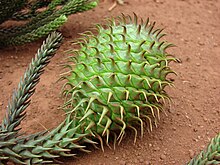
Apophyses on the tips of the cone scales of Araucaria cunninghamii amount to spikes.

Hairs on the leaves of Meniocus linifolius (formerly Alyssum linifolium) are stellate and appressed to the leaf surface.

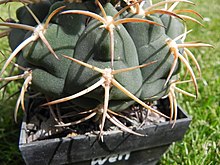


Infructescence of wild rye, showing prominent awns

Anatomy of an awn and bristles on a species of the Australian grass Rytidosperma longifolium

Axillary buds in leaf
B
[edit]- baccate
- Fruit appearing like a berry that may or may not be a true berry.[22]
- baculiform
- Rod-like; longer than wide. Compare cylindrical.
- barb
- A rear-facing point, as in a fish hook.
- barbed
- Having barbs pointing in one direction.
- barbellate
- Having barbed hairs (barbellae).
- bark
- The protective external layer of tissue on the stems and roots of woody trees and shrubs; includes all of the living and non-living tissue external to the cambium.
- basal
- Situated or attached at or close to the base (of a plant or a phylogenetic tree diagram).
- basifixed
- Something attached by its base, e.g. an anther attached to the filament. Compare dorsifixed.
- basipetal
- Developing sequentially from the apex toward the base (i.e. with the youngest toward the base), e.g. of flowers in an inflorescence. Also, moving from leaves to roots, e.g. of molecular signals in plants.
- bathyphyll
- A specialized leaf produced at the base of a plant, usually when the plant is immature, and which serves to anchor the plant to a substrate; especially notable in the fern Teratophyllum. Contrast acrophyll.
- beak
- A prominent, pointed terminal projection, especially of a carpel or fruit.
- berry
- A type of indehiscent fruit with the seeds immersed in the pulp, e.g. a tomato.
- bi-
- A prefix meaning "two", e.g. bisulcate, having two sulci or grooves.
- biennial
- A plant which completes its life cycle (i.e. germinates, reproduces, and dies) within two years or growing seasons. Biennial plants usually form a basal rosette of leaves in the first year and then flower and fruit in the second year.
- bifid
- Forked; cut in two for about half its length. Compare trifid.
- bifoliate
- (of a compound leaf) Having precisely two leaflets, usually in a symmetrical pair, e.g. a leaf of Colophospermum mopane. Compare jugate lobed leaf, e.g. most species of Bauhinia.
- bifusiform
- Fusiform with a pinch in the middle.
- bilabiate
- Having two lips, e.g. the form of the petals in many irregular flowers.
- bilateral
- 1. Having two distinguishable sides, such as the two faces of a dorsiventral leaf.
- 2. Arranged on opposite sides, e.g. leaves on a stem; Compare distichous and opposite.
- 3. Bilaterally symmetrical, as in a leaf with a symmetrical outline.
- biloculate
- Having two loculi, e.g. in anthers or ovaries.
- binomial
- Making use of names consisting of two words to form the scientific name (or combination) in a Latin form. For example, where the first is the name of the genus to which the species belongs, and the second is the specific epithet given to that species to distinguish it from others in the same genus.
- binomial nomenclature
- The system of nomenclature in which the scientific name of a species (and not of a taxon at any other rank) is a combination of two names, the first name being the generic name. The second name is referred to botanically as the specific epithet. Note that the two names together (not just the second name) constitute the species name.
- bipinnate
- Doubly pinnate; e.g. a compound leaf with individual leaflets pinnately divided.
- bipinnatisect
- A pinnatisect leaf with deeply dissected segments.
- bisexual
- Bearing both male and female reproductive organs; usually, flowers with both stamens and carpels; synonymous with hermaphrodite, synoecious, and monoclinous. Bisexual flowers occur only on monoecious plants. See also androgynous, monoicous, and plant reproductive morphology.
- bitegmic
- (of an ovule) Covered by two integuments. Contrast unitegmic.
- biternate
- Ternate, with each division divided into three.
- bivalve
- Having two valves or hinged parts. Contrast trivalve.
- blade
- The lamina or flattened part of a leaf, excluding the stalk or petiole.
- bloom
- A fine white or bluish waxy powder occurring on plant parts, usually stems, leaves, and fruits. It is easily removed by rubbing.
- bole
- The trunk of a tree, usually the portion below the lowest branch. Compare canopy.
- bostrychoid
- Arranged on a conical surface (like a snail shell); used to describe inflorescences in which the buds are arranged in an almost helical manner on the outside of a long, tapering, conical rachis.
- bract
- A modified leaf associated with a flower or inflorescence and differing in shape, size, or color from other leaves (and without an axillary bud).
- bracteate
- Possessing bracts.
- bracteole
- A small bract borne singly or in pairs on the pedicel or calyx; synonymous with bractlet.
- bracteolate
- Possessing bracteoles (bractlets).
- bracteose
- Having many or showy bracts.[23]
- bractlet
- See bracteole.
- branchlet
- A small branch.
- brevideciduous
- A plant that loses all of its leaves only briefly before growing new ones, so that it is leafless for only a short time, e.g. approximately two weeks.
- bristle
- A straight, stiff hair (smooth or with minute teeth); the upper part of an awn (when the latter is bent and has a lower, stouter, and usually twisted part, called the column).
- brochidodromous
- Pinnate leaf venation in which the secondary veins do not terminate at the leaf margin, but are joined in a succession of prominent arcs.
- brochus
Width of one lumen of a pollen grain reticulum and half of the width of the surrounding muri (walls), hence heterobrochate and homobrochate, where the lumina are of different or similar sizes, respectively.
- bryophyte
- Informally, any plant that is a moss, hornwort, or liverwort. Formally, these plants are placed in three separate divisions: hornworts (Anthocerophyta), liverworts (Marchantiophyta), and mosses (Bryophyta).
- bulb
- A thick storage organ, usually underground, consisting of a stem and leaf bases (the inner ones fleshy).
- bulbel
- A bulb arising from another bulb. See bulblet.
- bulbil
- A small, deciduous bulb or tuber formed in the axil of a leaf or pinna; a means of vegetative propagation.
- bulblet
- A bulb arising from another bulb; a bulbel.
- bullate
- 1. Having a rounded or blister-like appearance; arched or vaulted.
- 2. (of a leaf) Having arched leaf tissue between each lateral vein, i.e. the veins appear depressed in the leaf surface.
- burl
- A deformation or knot in the branches or trunk of a tree, sometimes sought after in woodworking.[24]
- burr
- 1. A prickly fruit.
- 2. A rough or prickly propagule consisting of a seed or fruit and associated floral parts or bracts.
- buttress root
- A root growing from an above-ground stem or trunk, and providing support, e.g. commonly of Ficus macrophylla.

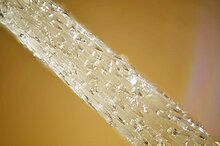
Barbs occur on the spines of some species of cactus, as shown here, enlarged.

Berries of Olinia ventosa, including a cross-section showing hard seeds in the pulp

The bifoliate compound leaves of the mopane tree, Colophospermum mopane, suggest the common name "butterfly tree".

Cross-section of a silique of Arabidopsis thaliana, showing it to be biloculate, formed of two carpels, morphologically a silique and not a pod

Bipinnate leaf of Gymnocladus dioicus

Structure of a biternate compound leaf

This African baobab, Adansonia digitata, has an enormous bole beneath a relatively modest canopy that is typical of this species.

The large, colorful bracts of Bougainvillea are commonly mistaken for its petals.

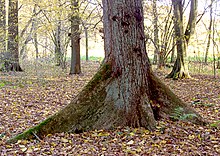
Buttress root of a mature elm
C
[edit]- caducous
- Falling off early, e.g. the sepals of poppies, which fall off when the petals begin to open. Compare persistent and fugacious.
- caespitose
- Tufted or turf-like, e.g. the growth form of some grasses and sedges.
- calcarate
- possessing a spur.
- calcareous
- A soil type or a lichen substrate rock type that is rich in or largely composed of calcium carbonate.
- calceolate
- Shaped like a slipper.[25]
- calcicole
- A plant which thrives in calcareous soil. Also calciphile, calciphyte. Antonym: calcifuge. [25]
- callose
- Hardened; thickened; callous.
- callus
1. A protruding mass of tissue
- 2. Undifferentiated tissue growth formed in response to wounding; may be grown in vitro.
- 3. In orchids, fleshy outgrowths from the labellum which can be variously shaped from papillae to plates.
- 4. In grasses, a hardened extension from the base of a floret (formed from the rachilla joint and/or the base of the lemma), which may or may not elongate and is often covered in hairs or bristles.
- calyciflorous
- Having petals and stamens attached to the calyx.
- calycophyll
- Leaf-like structure formed from a sepal or calyx lobe which enlarges, usually many-fold, before or after anthesis, especially when most of the other sepals or calyx lobes retain their original size. More extreme than an accrescent calyx, calycophylls are found in Rubiaceae. Compare semaphyll and pterophyll.
- calyculate
- Having an epicalyx.
- calyculus
- 1. A cup-shaped structure formed from bracts resembling an outer calyx.
- 2. In some Asteraceae, a circle of bracts below the involucre.
- calyptra
- A hood or lid. See operculum.
- calyx
Collective term for the sepals of one flower; the outer whorl of a flower, usually green. Compare corolla.
- calyx tube
- A tube formed by the fusion of the sepals (calyx), at least at the base.
- cambium
- Tissue layer that provides partially undifferentiated cells for plant growth.
- campanulate
- Bell-shaped.
- camptodromous
- Pinnate venation in which the secondary veins curve toward the margins, in some cases becoming nearly parallel with them, and not reconnecting with other veins to form loops.
- campylotropous
- When the ovule is oriented transversely (i.e. with its axis at right angles to its stalk) and with a curved embryo sac. Compare amphitropus, anatropous, and orthotropous.
- canaliculate
- Channelled; having a longitudinal groove.
- canescent
- Approaching white in color, as in a leaf covered with white down or wool.
- canopy
- Branches and foliage of a tree; the crown. Also refers to the protective upper layer of a forest. Compare trunk.
- capillary
- 1. Tube, pore, or passage with a narrow, internal cross-section.
- 2. Slender; hair-like.
- capitate
- 1. (of an inflorescence) Having a knob-like head, with the flowers unstalked and aggregated into a dense cluster.
- 2. (of a stigma) Like the head of a pin.
- capitulum
- Dense cluster of sessile or subsessile flowers or florets, e.g. a flower head in the daisy family Asteraceae. See pseudanthium.
- capsule
- Dry fruit formed from two or more united carpels and dehiscing when ripe (usually by splitting into pieces or opening at summit by teeth or pores).
- carduoid
- In Asteraceae, having a style with a ring of sweeping hairs borne on the shaft of the style below the style branches.
- carina
- See keel.
- carinal canal
- Longitudinal cavity in the stems of Equisetum and extinct Equisetopsida, coinciding with a ridge in the stem surface.
- carneous
- Flesh-colored, especially as applied to some flowers.
- carnose, carnous
- Fleshy or pulpy in texture, especially as applied to some tissues or organs. Contrast coriaceous and corneous.
- Caropodium
- Genus of flowering plants in the family Apiaceae. Native range: Turkey to Iran. Not to be confused with Carpopodium
- carpel
- The basic female reproductive organ in angiosperms, either consisting of a single sporophyll or a single locule of a compound ovary, with a style and a stigma. The gynoecium is the collective term for all of the carpels of a single flower.
- carpellary
- Referring to carpels or to associated structures or outgrowths of carpels, for example staminodes attached to carpels in Nymphaeaceae, were frequently referred to as carpellary attachments. The current and past usage of the terms "carpellary attachments", paracarpels, and staminodes is confused and varies among authors.
- carpopodium
- On achenes (Cypselae), an elongation of the base of the gynoecium which looks distinct; the abscission zone, where the achene is separated from the receptacle.
- 2. Genus Carpopodium in the family Brassicaceae; not to be confused with Caropodium.
- cartilaginous
- Hard and tough; gristly. Compare corneous and coriaceous.
- caruncle
- A small piece of flesh-like tissue, typically lumpy or warty, growing on the testa near the hilum. Contrast aril.
- caryopsis
- A dry, indehiscent, one-seeded fruit in which the seed coat is closely fused to the fruit wall, e.g. in most grasses.
- Casparian strip
- A continuous band of suberin in the radial primary cell walls of the endodermis in vascular plant stems and roots that forms a permeability barrier to the passive diffusion of external water and solutes into the vascular tissue.
- cassideous
- Hood-, helmet- or bonnet-shaped; generally referring to floral anatomy, e.g. in the flowers of Aconitum, Satyrium, etc.
- castaneous
- Chestnut-colored, reddish-brown.[26]
- casual alien
- An exotic plant that appears with no apparent human assistance but does not develop a sustained population(s), or one that persists only by repeated new introductions. Compare alien.
- cataphyll
- Any plant structure which is morphologically a leaf but which has at most an incidental or transient photosynthetic function. They are either shed when their main function has been completed, or are incorporated into structures where, when dead, they serve a protective or supportive purpose.
- catenulate
- In the shape of a chain; formed of parts or cells connected as if chained together, e.g. some diatoms, algae, and cyanobacteria such as Anabaena. See also concatenate.
- catkin
- A spike, usually pendulous, in which the mostly small flowers are unisexual and without a conspicuous perianth, e.g. in willows, poplars, oaks, and casuarinas. The individual flowers often have scaly bracts and are generally wind-pollinated. Catkins are usually shed as a unit.
- caudate
- Having a narrow, tail-like appendage or tip, e.g. a drip tip. Contrast acuminate, cuspidate, and mucronate.
- caudex
The stem of a plant, especially a woody one; also used to mean a rootstock, or particularly a basal stem structure or storage organ from which new growth arises. Compare lignotuber.
- caudiciform
- Stem-like or caudex-like; sometimes used to mean "pachycaul", meaning "thick-stemmed".
- caulescent
- possessing a well-developed stem above ground, similar to cauline. Antonym: acaulescent (lacking an apparent stem).
- cauliflory
Having flowers or fruits growing directly from a tree's branches or trunk.[27]
- cauline
- Borne on an aerial stem or caulis, as with leaves, flowers, or fruits (when applied to the latter two organs, usually referring to older stems.
- caulirosulate
- Borne at the end of the stem or caulis, as with leaves or bracts.
- cell
- 1. The basic, microscopic unit of plant structure, generally consisting of compartments in a viscous fluid surrounded by a cell wall.
- 2. A cavity of an anther or ovary.
- cenanthous
- (of a perianth) Lacking both stamens and pistil, i.e. a flower with neither androecium nor gynoecium.
- centrifixed
- Of a two-branched organ attached by its center, e.g. a hair or anther.
- ceraceous
- Having a waxy appearance, color, or texture, e.g. flowers of many species of Ceropegia, and the waxy fruit of some species of Myrica.
- cernuous
- Nodding, falling headlong or face down; inclined, stooping, or bowing forward. Applied to many species with a nodding, stooping habit, such as many Narcissus and Dierama species. Many plant species bear the specific epithet "cernua".
- cespitose
- An alternative spelling of caespitose, meaning tufted or turf-like, e.g. the growth form of some grasses.
- chamber
- A cavity of an ovary.
- channelled
- Sunken below the surface, resulting in a rounded channel.
- chartaceous
- Having a papery texture.
- chasmogamous
- Of flowers that are pollinated when the perianth is open. Compare cleistogamous.
- chasmophyte
- A plant adapted to growing in crevices or hollows, such as in cliff faces. Compare cremnophyte.[28][29]
- chimera
- An individual composed of two or more genetically distinct tissues, most commonly as a result of a graft and sometimes by mutations that occur during cell division or cellular transfers during seed development.
- chiropterophilous
- Pollinated by bats.
- chlorophyll
- Any of a variety of different chemical pigments in chloroplasts that are essential for photosynthesis.
- chloroplast
- An organelle present in plant cells which contains chlorophyll.
- chlorosis
- An abnormal lack or paleness of color in a normally green organ.
- cilia
Very small hairs or hair-like protrusions more or less confined to the margins of an organ, as with eyelashes; in motile cells, minute, hair-like protrusions which aid motility.
- cinereous
- Ash-colored, grayish, usually because of a covering of short hairs; somewhat darker than canescent.
- circinate
- Spirally coiled with the tip innermost, e.g. circinate vernation of the developing fronds of most ferns.
- cirrhose
- (of a leaf) Ending in a tendril at the apex.
- cirrus
- See tendril.
- cladode
- A photosynthetic branch or stem, often leaf-like and usually with foliage leaves either absent or much reduced. Compare phyllode.
- class
- The principal category for taxa ranking between division and order.
- clathrate
- Shaped like a net or lattice; pierced with apertures, as with a cage.
- clavate
- Club-shaped.
- clavuncula
- In the Apocynaceae, an enlarged, drum-shaped stigma of which the sides and lower surface are the receptive zones. Coherent with the anthers or not.
- claw
- 1. A narrow, stalk-like, basal portion of a petal, sepal, or bract.
- 2. In Melaleuca, the united portion of a stamen bundle.
- cleistogamous
- Having flowers which self-pollinate and never open fully, or which self-pollinate before opening. Compare chasmogamous.
- climber
- A plant growing more or less erect by leaning on or twining around another structure for support, or by clinging with tendrils.
- climbing
- See climber.
- cline
A continuous morphological variation in form within a species or sometimes between two species.
- clone
- A plant derived from the asexual vegetative reproduction of a parent plant, with both plants having identical genetic compositions.
- coalescent
- Having plant parts fused or grown together to form a single unit.
- cochleariform
- Concave and spoon-shaped.
- cochleate
- Coiled like a snail's shell.
- coenobium
- An arranged colony of algae that acts like a single organism.
- coenocyte
- A single cell with multiple nuclei, formed when nuclear division was not followed by cytokinesis.
- coleoptile
- One type of sheath in the structure of monocotyledonous seeds. The coleoptile is a protective sheath or cap (pileus), generally more or less pointed, that covers the monocotyledonous plumule as it emerges from the soil. It generally turns green and contributes to photosynthesis until its function is superseded by the main growth of the seedling. Contrast this with the coleorhiza, which remains underground until it is superseded as the roots emerge.
- coleorhiza
- One type of sheath in the structure of monocotyledonous seeds. The coleorhiza connects the coleoptile to the radicle and protects the monocotyledonous radicle during germination. Unlike the coleoptile, the coleorhiza is associated with the root and does not emerge from the soil during germination. Contrast coleoptile.
- collenchyma
- A specialized tissue consisting of living cells with unevenly thickened cellulose and pectin cell walls that performs a support function in organs such as leaves and young stems that are composed of primary plant tissues.
- colleter
- A multicellular, glandular hair that usually produces a mucilaginous substance and is located on sepals, stipules, or petioles, or on nearby parts of stems; commonly found on plants in the order Gentianales.
- columella
- In flowering plants, the central axis of the cone or fruit, e.g. in Callitris.
- column
- 1. A structure extending above the ovary and incorporating the style and stamens also known as the gynostegium, e.g. in orchids and milkweeds.
- 2. In grasses, the lower, stouter, and usually twisted part of an awn, distinct from the slender upper part or bristle.
- columnar
- Shaped like a column.
- coma
- 1. A tuft of hairs from testa or funiculus at one or both ends of some seeds, e.g. in Strophanthus, Asclepias, or Alstonia.
- 2. Sterile bracts, e.g. in Curcuma, Ananas, or Eucomis.
- 3. Sterile flowers, e.g. in Muscari and Leopoldia, at the apex of some inflorescences.
- 4. A tuft of hairs at the base of some flowers, e.g. in Pfaffia gnaphalioides.
- 5. A tuft of hairs at the apex or base of some spikelets.
- 6. An axil tuft of hairs in inflorescences in some Poaceae, e.g. in Eragrostis comata.
- commercial name
- A name often of no botanical standing and not governed by the ICNCP. The term generally applies to names such as Trademark Names, names covered by Plant Breeders Rights, Patents and Promotional Names, which are often used to enhance the sale of a plant.
- commissure
- The seam or face at which two carpels adhere. See also fissure and suture.
- community
- An ecological assemblage of plants that characteristically occur together.
- compound
- Composed of several parts, e.g. a leaf composed of multiple leaflets, a gynoecium composed of multiple carpels, or an inflorescence made up of multiple smaller inflorescences.
- compound palmate
- Having leaflets that radiate from a central point (usually at the top of a petiole), like spread-out fingers radiating from the palm of a hand. Compare palmate.
- compressed
- Flattened lengthwise, either laterally (from side to side) or dorsally (from front to back).
- concatenate
- Joined together in a chain-like form. See also concatenate and catenate.
- concolorous
- Having the same color throughout; uniformly colored.
- conduplicate
- Arranged such that two sides of a flat surface are folded along the midline to face each other. See also ptyxis, aestivation, and vernation.
- cone
- A type of fruit, usually woody, ovoid to globular, including scales, bracts, or bracteoles arranged around a central axis, e.g. in gymnosperms, especially conifers and Casuarina.
- conflorescence
- A rarely used term describing substantial differences between the overall structure of an inflorescence and that of its individual branches, e.g. the bottlebrush multiple-flower head of members of the genus Callistemon.
- connate
- Fused to another organ (or organs) of the same kind, e.g. petals in a gamopetalous corolla tube. Compare adnate.
- connective
- The part of an anther that connects the anther cells.
- connivent
- Coming into contact or converging.
- conspecific
- Belonging to the same species.
- contiguous
- Adjoining, touching, but not united.
- contort
- (of sepals or petals) A type of imbricate aestivation in which one side of each segment overlaps one of the adjacent segments and the other side is overlapped by the other adjacent segment. See convolute.
- contorted
- Twisted out of the normal shape.
- convolute
- 1. Referring to the arrangement of floral or foliar organs in a bud when each organ or segment has one edge overlapping the adjacent organ or segment; a form of imbricate arrangement. See contort.
- 2. (of leaves) A type of vernation in which one leaf is rolled up inside another.
- 3. A type of vernation of two leaves at a node, in which one half of each leaf is exposed and the other half is wrapped inside the other leaf.
- corcle
- A plant embryo, plumule, or plumule plus radicle.
- cordate
- Heart-shaped, with the notch lowermost; of the base of a leaf, like the notched part of a heart. Contrast obcordate.
- coriaceous
- Leathery; stiff and tough, but flexible. Compare corneous.
- corm
A fleshy, swollen stem base, usually underground and functioning in the storage of food reserves, with buds naked or covered by very thin scales; a type of rootstock.
- cormel
- A small corm (or cormlet), forming at the base of a growing larger corm.[30]
- corneous
- Horny in texture; stiff and hard, but somewhat tough. Compare coriaceous.
- corolla
- A collective term for the petals of a flower. Compare calyx.
- corona
- 1. In flowering plants, a ring of structures that may be united in a tube, arising from the corolla or perianth of a flower and standing between the perianth lobes and the stamens. The trumpet of a daffodil is a corona.
- 2. In grasses, a hardened ring of tissue surmounting the lemma in some species.
- cortex
A region of tissue located between the surface cells and the vascular cylinder.[31]
- corticolous
- Growing on bark or on wood with the bark stripped off. Compare lignicolous.
- corymb
An inflorescence with branches arising at different points but reaching about the same height, giving the flower cluster a flat-topped appearance.
- costa
- A rib.
- costapalmate
- Having a definite costa (midrib), unlike the typical palmate or fan leaf, but with the leaflets arranged radially as in a palmate leaf.
- cotyledon
- The primary leaf or leaves of a plant embryo which upon germination develops into the seed-leaf or the first set of leaves.
- craspedodromous
- Pinnate venation in which the secondary veins terminate at the margins, often as teeth.
- crateriform
- In the shape of a saucer or shallow cup; hemispherical or more shallow.
- cremnophyte
- A plant adapted to growing on, especially hanging from, cliff faces or crevices. Compare chasmophyte.[28][29]
- crenate
- Having blunt or rounded teeth; scalloped.
- crenulate
- Minutely scalloped.
- crisped
- Finely curled, as with the edges of leaves and petals.
- cristarque cell
- A sclereid which contains a druse and has the lignin deposited excentrically on the cell wall to form a cup shape, or in cross-section, a ∪-shape.
- crown
- See canopy.
- cross
- To make something interbreed; the act of hybridization.
- cruciform
- Cross-shaped.
- crustaceous
- Hard, thin and brittle.
- crustose
- Forming a closely applied surface layer or crust.
- cryptogam
- Any of the "lower plants" which produce spores and do not have stamens, ovaries, or seeds; literally, plants whose sexual reproductive organs are not conspicuous. This group typically includes the ferns, bryophytes, and algae, and sometimes fungi (including lichenized fungi). Compare phanerogam.
- cucullate
- Hood-like or hooded, commonly referring to the shape of leaves or petals, e.g. Pelargonium cucullatum. Similarly derived terms include cuculliform and cuccularis.
- culm
- In grasses, sedges, rushes, and some other monocotyledons, an aerial stem bearing the inflorescence, extending strictly from the base of the plant to the lowest involucral bract (or base of the inflorescence).
- cultigen
- A plant whose origin or selection is primarily due to intentional human activity.
- cultivar
- A term derived from "cultivated variety" denoting an assemblage of cultivated plants clearly distinguished by one or more characters (morphological, physiological, cytological, chemical, or other). When reproduced (either sexually or asexually), the assemblage retains its distinguishing characters. A cultivar may arise in cultivation or be introduced from the wild. It is a variant that is of horticultural interest or value. Cultivar names are written with single quotation marks around them, e.g. 'Blue Carpet' or 'Alba'. All new names established after 1 January 1959 must be in common language (that is, not in Latin), but names established in Latin prior to this date are retained in Latin form.
- cultivar epithet
- The defining part of a name that denominates a cultivar. Cultivars are designated by fancy (q.v.) epithets appended either to the scientific name or to the common name of the taxon to which they belong; they are not italicized but placed in single quotation marks, e.g. Rubus nitidoides 'Merton Early'. 'Merton Early' is the cultivar epithet.
- cuneate
- Wedge-shaped, with straight sides converging at a base.
- cupule
- A cup-shaped structure composed of coalescent bracts, such as the cup of an acorn. See calybium.
- cupular
- Shaped like a cupule.
- cupulate
- Bearing cupules.
- cupuliform
- Nearly hemispherical, shaped like a cupola or dome.
- cusp
- A hard, pointed tip, stiffer and more formidable than a mucro, hence cuspidate.
- cuspidate
- Tipped with a cusp, as with some leaves.
- cuticle
- A waterproofing layer covering the epidermis of aerial plant surfaces and composed of the polymers cutin, and/or cutan and waxes.
- cutting
- An apical tip of shoot structure, root, or leaf which is cut from a plant and used for asexual vegetative propagation.
- cyathium
An inflorescence of unisexual flowers surrounded by involucral bracts, especially the flowers of Euphorbia.
- cyathophyll
- In Euphorbia, the bract-like structure on which the involucre sits, usually but not always occurring in twos. They may sometimes be brightly colored and confused with petals.
- cylindrical
- Rod-like and two to three times as long as wide. Compare baculiform.
- cynaroid
- See carduoid.
- cyme
A type of inflorescence in which the main axis and all lateral branches end in a flower (each lateral may be repeatedly branched).
- cymose
- Having a cyme or cymes.
- cypsela
- A type of dry, one-seeded, indehiscent fruit formed from an inferior ovary.
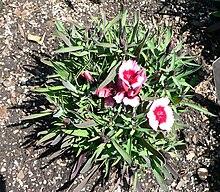
Dianthus chinensis has a caespitose growth habit.


Structure of flower of an orchid in genus Praecoxanthus, with the callus labelled

Bearded callus of a floret of the grass species Chrysopogon filipes

Scanning electron micrograph of the carpopodium at the base of the achene-like fruit of Zyzyura mayana, Asteraceae

Dormant leaf buds of deciduous trees are commonly protected by imbricate cataphylls that are shed when the bud sprouts.

Male catkins of Betula pendula

The caudex of Dioscorea elephantipes grows largely above the soil surface. Many species that form caudices grow them underground.
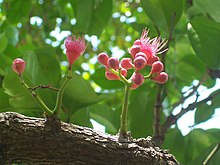
Flowers growing from a branch of Syzygium moorei, an example of cauliflory

Some members of the Espeletia genus exhibit a growth habit that is caulirosulate.

Moehringia growing as a chasmophyte on an overhanging cliff
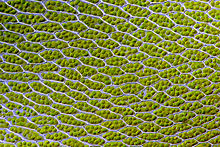
Chloroplasts within the cells of the leaves of the moss Bryum capillare

Not all chloroplasts are simple in shape. Chloroplasts of Spirogyra are helical within the tubular cells of their algal filaments.
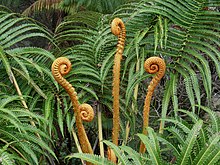

The so-called "fleshy leaves" of cacti, such as on this Opuntia tomentosa, are actually cladodes (branches). The true leaves are the spines growing on the cladodes, which on this young cladode are still fleshy.

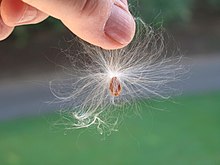

Curcuma pseudomontana with red coma bracts

Pfaffia gnaphalioides flowers with basal coma hairs

Coma atop Muscari armeniacum, bearing sterile flowers
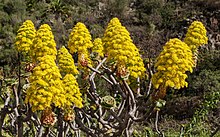
The conical compound inflorescence of Aeonium arboreum is a compound panicle composed of minor panicles, some of which are compound in their turn.

California buckeye (Aesculus californica) has a compound palmate leaf, the leaflets radiating from a central point.


Casuarina equisetifolia male and female flowers and cones

Gamopetalous Watsonia flower split open between two petals to show the connate formation of the corolla tube; compare the adnate attachment of the stamen bases to the matching petals

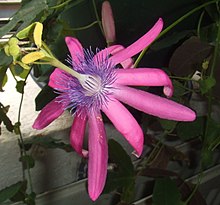
The corona of this Passiflora flower is a ring of purple filaments between the petals and the stamens.

Cotyledons of seedlings of Koelreuteria. One plant shows the first new leaves above its cotyledons, and the rest show various younger stages of emerging cotyledons.
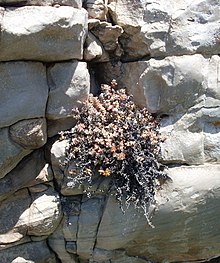

Nymphoides crenata has crenate leaf margins.

Mimetes cucullatus, so named for the hooded, cucullate shape of its white flowers

Murraya paniculata has leaves with cuneate (wedge-shaped) bases.

Examples of cupules of Fagaceae:
A: Quercus rubra B: Quercus trojana
C: Fagus sylvatica D: Castanea sativa
A: Quercus rubra B: Quercus trojana
C: Fagus sylvatica D: Castanea sativa

Cuspidate leaves of Diplacus bigelovii var. cuspidatus
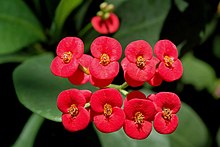
Euphorbia milii is commercially grown for the aesthetic appearance of its brightly colored, bract-like structures called cyathophylls, which sit below the inflorescence.
D
[edit]- deciduous
- Dehiscing and falling seasonally, as with bark, leaves, or petals. Contrast persistent.
- declinate
- Curving downward, and then upward at the tip. Often qualified, e.g. declinate-ascendant.
- decompound
- Divided to more than one level, e.g. in bipinnate leaves, in which the leaflets of what would otherwise be a pinnate leaf are themselves pinnately divided.
- decorticate
- 1. (intr. v.) To shed the outer bark of a tree, usually seasonally as part of the natural growth cycle.
- 2. (tr. v.) To strip the peel, crust, bark, or other surface tissues from a plant or from harvested material, such as in extracting fiber from harvested Agave leaves.
- decumbent
- Having branches growing horizontally along the ground but which are turned up at the ends.
- decurrent
- Extending downward beyond the point of insertion, e.g. when the base of a leaf or a fungal gill is prolonged downward along the stem in a raised line or narrow wing.
- decussant
- A synonym of decussate; the usage decussant is questionable and occurs rarely, probably as an error. The formally correct usage is decussate.
- decussate
- Opposite with successive pairs borne at right angles to the last; generally applied to the arrangement of leaves.
- definite
- Of a constant number, e.g. twice as many stamens as petals or sepals (or less), or an inflorescence ending in a flower or an aborted floral bud, typically a cymose inflorescence. Contrast indefinite.
- deflexed
- Bent downward. Contrast inflexed.
- dehiscent
- Breaking open at maturity to release contents; refers e.g. to the opening of fruits to release seeds, of anthers to release pollen, and of sporangia to release spores. Contrast indehiscent.
- deltoid
- Shaped like the uppercase Greek letter Δ, i.e. like a more or less equilateral triangle.
- dendroid
- Tree-like; branching like a tree.
- dentate
- Toothed, especially in reference to leaf margins.
- denticulate
- Finely toothed; a diminutive form of dentate.
- deserticolous
- Inhabiting a desert.
- determinate
- Limited, usually in growth. Contrast indeterminate.
- diadelphous
- Referring to a class of adelphous structure in which the stamens or similar organs are connected in two adelphiae instead of just one.
- diaspore
- Any reproductive part of a plant adapted for dispersal and for establishing new plants; may be a disseminule such as a seed, or other parts such as specialized buds, branches, inflorescences, or fruits.
- dichasium
- A cymose inflorescence with all branches below the terminal flower in regular opposite pairs. Compare monochasium and pleiochasium.
- dichlamydeous
- Having a perianth which is divided into a separate calyx and corolla. Compare homochlamydeous.
- dichotomous
- Forking into two equal branches. This may result from an equal division of the growing tip, or may be sympodial, in which the growing tip is aborted and replaced. Typically refers to mode of branch growth, as in Aloidendron dichotomum, but also to other organs, such as the venation patterns on leaves, the thorns of various species of Carissa (which morphologically are branches), and the thalli or hyphae of various algae and fungi.
- dicotyledon
A flowering plant whose embryo has two or more cotyledons (seed leaves). Contrast monocotyledon.
- digitate
- With segments spreading from a common center, like the fingers of a hand. See also palmate and palmatisect. See also Leaf shape.
- digitiform
- Shaped like a finger.
- dimorphic
- Occurring in two different forms (with respect to shape and/or size), e.g. of stamens, fronds, or leaves. See also monomorphic (having a single form) and polymorphic (having many forms).
- dioecious
- (of vascular plants) Having male and female reproductive structures which develop only on different individuals and never on the same individual. Contrast monoecious.
- dioicous
- (of a bryophyte gametophyte) Having male and female reproductive structures which develop only on different individuals and never on the same individual. Contrast monoicous.
- diploid
- Having two complete sets of chromosomes in the nucleus of a sporophyte cell, i.e. one set from each of the parental gametes. This is often expressed symbolically as 2n, where n = the number of chromosomes in the haploid gamete.
- diplostemonous
- Having stamens arranged in two whorls, with the outer whorl alternating with the petals while the inner whorl is opposite the petals. Compare obdiplostemonous and haplostemonous.
- disc
A plate or ring of structures derived from the receptacle, and occurring between whorls of floral parts. In some groups, especially Sapindales, the nectary is in the form of a prominent disk. In daisies, the central part of the capitulum is a disk, hence flowers borne there are called disk flowers or florets.
- discoid
- Resembling a disc or plate, having both thickness and parallel faces and with a rounded margin. Also used to describe the flower head of Asteraceae where there are no ray florets but only disc florets.
- discolorous
- (of leaves) Having upper and lower surfaces of different colors.
- disjunct
- Occurring in widely separated geographic areas, distinctly separate; applies to a discontinuous range in which one or more populations are separated from other potentially interbreeding populations with sufficient distance so as to preclude gene flow between them.
- disk floret
- A floret occurring most typically in the disk of the capitulum of flowers in the family Asteraceae, and to some extent in other plants that bear a flowering head with a disk, such as Scabiosa.
- dissected
- Deeply divided; cut into many segments.
- dissepiment
- A partition or septum in a plant part, usually referring to septa between the loculi of capsules or of other fruits with multiple partitions.
- distal
- Remote from the point of origin or attachment; the free end. Contrast proximal.
- distichous
- Arranged in two opposite rows (and hence in the same plane).
- distinct
- Separate or free; not united.
- distyly
- The condition in which the flowers of a species occur in two forms that differ only by the length of the style and stamens, and flowers of only one of these forms appear on any one plant. Compare heterostyly.
- diurnal
- Of the day; occurring or opening in the daytime.
- divaricate
- Wide-spreading.
- divergent
- Spreading in different directions, generally upward.
- division
- A taxonomic rank below kingdom in the standard taxonomic hierarchy. "Division" is generally used only for plants, and is the approximate botanical equivalent of the term phylum, which is used for animals and other kingdoms.
- domatia
Any hollow structure formed by a plant that is inhabited by animals such as ants or mites.
- dorsal
- From Latin dorsum, a ridge or the back of an animal. Partly because the term originally referred to animals rather than plants, usage in botany is arbitrary according to context and source. In general "dorsal" refers to "the rear or back or upper surface", but in botanical usage such concepts are not always clearly defined and may be contradictory. For example:
- facing away from the axis (abaxial) in a lateral organ of an erect plant
- facing away from the substrate in any part of an erect plant, for example the upper surface of a more or less horizontal leaf (adaxial) or the upper part of the crown of the plant
- facing away from the substrate in a prostrate or climbing plant or floating leaves such as those of Nymphaea.
- dorsifixed
- Attached at or by the back, e.g. anthers on a filament.
- dorsiventral
- Having structurally and visibly different upper and lower surfaces, e.g. some leaves. Compare bilateral and isobilateral.
- drip tip
- A long, narrow, acuminate, caudate, or cuspidate extension at the tip of a leaf or leaflet. Commonly an adaptation to rainy conditions, as it promotes shedding of water by its dripping from the narrow tip. The term drip tip is not anatomically descriptive in the way that acuminate or cuspidate are, for example; rather, it is a description of the functional shape that aids dripping, regardless of the specific geometry of the shape itself.
- drupe
- A type of succulent fruit formed from one carpel; the single seed is enclosed by a stony layer of the fruit wall, e.g. in peaches and olives. Also called a kernel.
- drupelet
- A small drupe formed from one of the carpels in an apocarpous flower. Drupelets usually form a compound fruit, as in Rubus, but they may become widely separated, as in Ochna.
- druse
- A globular mass of calcium oxalate crystals, usually with the crystals radiating from an organic core.

Seasonal, healthy decortication of Eucalyptus grandis outer bark

A decorticating machine collecting fiber from leaves



Denticulate leaves of Ziziphus mauritiana

Astragalus austriacus is regarded as diadelphous because it has one stamen unattached to the main adelphia (bunch).


Discolorous leaves of Brachylaena discolor differ in color between their upper and lower surfaces.

Disk florets opening in a capitulum of a cultivated Helianthus. They open progressively from the edge to the center of the disk.

Dissepiment developing in tissue of carpels where they meet to form locules in the capsule of the ovary of Lilium
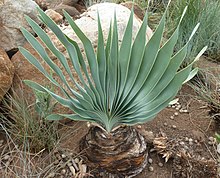
Boophone disticha has conspicuously distichous leaves.

Domatia at the bases of the thorns of Vachellia drepanolobium, the whistling thorn, with visible access holes


E
[edit]- -eae
- A suffix added to the stem of a generic name to form the name of a tribe, e.g. Aster → Astereae.
- ebracteate
- Lacking bracts; synonymous with ebracteolate.
- ecological amplitude
- The range of environmental conditions in which an organism can survive.
- edaphic
- Of or influenced by the soil.
- eglandular
Not having glands.
- elaiosome
- An external structure attached to the seed of many species of plants. Elaiosomes generally look fleshy and in some species they are rich in oils or other nutritious materials. Their functions vary and are not always obvious; commonly they attract ants or other animals that aid in dispersal, but they may also repel other animals from eating the seed.[32]
- elephophily
- A form of pollination whereby pollen or spores are distributed by the feet of elephants, as in Rafflesia arnoldii.
- ellipsoid
- A three-dimensional shape that is elliptical in all sections through the long axis.
- elliptical
Planar, shaped like a flattened circle, symmetrical about both the long and the short axis, tapering equally both to the tip and the base; oval.
- emarginate
- Typically in reference to leaf margins: notched or recessed at some part of the edge, such as the apex; the recess usually is broad and shallow. The location of a leaf's emargination(s) might be one or more of apical, lateral or basal
- embryo
- The young plant contained by a seed prior to germination.
- emergent
- A plant taller than the surrounding vegetation or, among aquatic plant species, one that bears flowers and commonly leaves above the surface of the water. Aquatic examples include water lilies, reeds, and papyrus. Some pondweeds such as Stuckenia are not emergent until they flower, at which time only their flowers appear above the water surface.
- enation
- Leaf-like outgrowth from a surface.[33]
- enantiostyly
- The condition in which the gynoecium protrudes laterally, to the right (dextrostyly) or to the left (sinistrostyly) of the androecium, e.g. Senna.
- endemic
- Having a natural distribution restricted to a particular geographic region. Compare native.
- endocarp
- The innermost layer of the wall of a fruit; in a drupe, the stony layer surrounding the seed.
- endodermis
- The innermost layer of the cortex of vascular plant roots, also present in the stems of pteridophytes. The radial walls are impregnated with suberin to form a permeability barrier known as the Casparian strip.
- endosperm
- 1. (angiosperms) A nutritive tissue surrounding the embryo of the seed, usually triploid, originating from the fusion of both polar nuclei with one gamete after the fertilization of the egg.
- 2. (gymnosperms) The prothallus within the embryo sac.
- endospory
- The production of spores that germinate into a reduced multicellular gametophyte contained within the spore wall. Contrast exospory.
- ensiform
- Shaped like the blade of a sword.
- entire
- 1. Not divided.
- 2. (of a margin) Smooth and not lobed or toothed (though possibly wavy or scalloped). See also entire in Glossary of leaf morphology
- entomophily
- A form of pollination whereby pollen or spores are distributed by insects.
- epecophyte
- Species of recent appearance, usually numerous and constant in the country, but confined to artificial habitats, such as meadows and ruderal vegetation and are dependent on humans for existence.[34]
- ephemeral
- Short-lived. See also caducous.
- epicalyx
- An involucre resembling an outer calyx, e.g. as in Hibiscus.
- epicarp
- The outer layer of the wall of a fruit, i.e. the "skin".
- epicormic
- Used to refer to buds, shoots, or flowers developing from the old wood of trees, especially after injury or fire.
- epicotyl
- The part of the plant axis or stem between the cotyledonary node and the first foliage leaves.
- epicuticular wax
- A layer of crystalline or amorphous wax deposited on the surface of the cuticle.
- epidermis
- An organ's outermost layer of cells, usually only one cell thick.
- epigynous
- Borne on the ovary; describes floral parts when attached above the level of the ovary and arising from tissue fused to the ovary wall. Compare hypogynous and perigynous.
- epilithic
- Growing on stone. Compare lithophytic, a plant growing on stone.
- epipetalous
- Of stamens that are attached to the petals.
- epipetric
- Growing on rock or stone, lithophytic, epilithic.
- epiphloedal
- Growing on the surface of bark. Contrast endophloedal (growing inside, not on, the bark) and epilithic (growing on rock, not bark).
- epiphyte
- A plant, alga or fungus that grows on another plant without deriving nourishment from it but using it for support.
- epiphytic
- Of an epiphyte; living on the surface of a plant. Compare epilithic, lithophytic.
- episepalous
- Of stamens that are attached to the sepals.
- epitepalous
- Of stamens that are attached to the tepals.
- epithet
- The adjectival component in a binomial scientific name, usually more specifically called a specific epithet; the final word or combination of words in a name of more than one word (other than a term denoting rank) that denominates an individual taxon. The simplest and commonest example is the second word in a two-word name of a species, such as "mirabilis" in Welwitschia mirabilis.
- epizoochory
- A type of seed dispersal that occurs when seeds or fruits physically adhere to the outside of vertebrate animal bodies.
- epruinose
- Not pruinose.
- equitant
- (of a leaf) Folded lengthwise and clasping another leaf.
- erect
- Upright, more or less perpendicular to the ground or point of attachment. Compare patent (spreading) and erecto-patent, between erect and patent.
- ericoid
- Having leaves like those of the European heaths (Erica); small and sharply pointed.
- erose
- (of a margin) Irregular as though nibbled or worn away.
- ethelochoric
- Deliberate introduction by seedlings, seeds or plants in a new habitat by humans.
- etiolation
- Weak growth due to lack of light, resulting in elongated stems and yellowish color.[35]
- even-pinnate
- Having an even number of leaflets in a compound leaf; synonymous with paripinnate.
- evergreen
- Not deciduous; having leaves all year.
- ex
- In nomenclature, indicating that the preceding author proposed the name but did not legitimately publish it, and that the succeeding author referred to the first author when legitimately publishing the name. See Author citation (botany).
- exalbuminous
- In seeds of a given species, having no endosperm, i.e. no albumen, e.g. in Fabaceae and Combretaceae.
- exocarp
- The outer layer of the pericarp, often the skin of fleshy fruits.
- exospory
- The production of spores that germinate into free-living multicellular gametophytes. Contrast endospory.
- exotesta
- The outer layer of the testa (seed coat). It is derived from the outer integument of the ovule.
- exotic
- Not native; introduced from another region or country.
- exserted
- Projected beyond, e.g. stamens beyond the corolla tube.
- exstipulate
- Lacking stipules.
- extrastaminal
- Outside the stamens or androecium, usually referring to the location of a nectary disk.
- extrorse
- (of anther locules) Opening toward the outside of the flower. Contrast introrse and latrorse.

Plants of the genus Corydalis bear seeds with attached elaiosomes, which have various functions, commonly attracting ants. On some Corydalis species, elaiosomes that attract ants also repel mice.[32]

Ficus lyrata is an example of a doubly-emarginate leaf with lateral and apical emargination; it also might be seen as a basally emarginate.

Petals of Heracleum sphondylium are variously emarginate at their tips. Flowers in the middle of the inflorescence have slightly emarginate petals, whereas flowers at the periphery are so deeply emarginate as to be almost cleft in two.
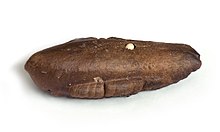


Iris pseudacorus has clearly ensiform leaves: narrow, straight-edged, sword-shaped.



Tillandsia recurvata growing as a harmless, non-parasitic epiphloedal epiphyte on a tree trunk that is also infested with an epiphloedal foliose lichen

Seeds or fruits are dispersed by epizoochory when they stick to the fur of animals.

The bases of equitant leaves enclose later leaves on the stem.

Sections of exalbuminous seeds
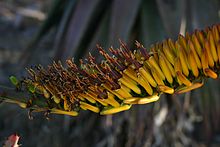
Aloe marlothii flowers with stamens and stigmata of mature flowers exserted from the mouths of the floral tubes
F
[edit]- F1 hybrid
- A single cross; a plant breeding term for the result of a repeatable cross between two pure bred lines.
- F2 hybrid
- A plant breeding term for the result of a plant arising from a cross between two F1 hybrids; may also refer to self-pollination in a population of F1 hybrids.
- fabiform
- Shaped like a kidney bean.
- facultative
- Able to perform a particular life function, or to live generally, in more than one way.[36] Compare obligate.
- falcate
- Curved like the blade of a scythe.
- family
- A taxonomic group of one or more genera with features, ancestry, or both in common. It is the term for the principal rank between order and genus.
- farina
- Powdery, pale yellow, crystalline secretion consisting of flavonoids in Primula and other species.
- farinaceous
- Powderiness that is mealy.
- fascicle
A cluster of flowers, leaves, needles, vascular tissue, etc., e.g. a tuft of leaves all arising from the same node.
- fasciculate
- Branching in clusters, e.g. a bundle of sticks or needles; having fascicles.
- fastigiate
- 1. In Plant morphology, the habit of a plant that consists in part, of a bundle of erect, more or less parallel branches or stems, particularly if they form or taper to a peak or point. (Latin fastigiatus,meaning "having a peak".
- 2. In palynology, the form of a pollen grain that has a fastigium, a pointed apex over a hollow between the layers of the pollen outer wall.
- faucal
- Pertaining to the fauces; located in the throat of a calyx or corolla.
- fauces
- The throat of a calyx or corolla; the conspicuously widened portion between the mouth and the apex of the tube. In Boraginaceae, the site of distinctive appendages.
- faveolate
- Honeycombed; having regular, angled pits. Compare foveolate.
- felted
- Having interlocked hairs to the extent of being matted.[28]
- female flower
- See pistillate flower.
- fenestrate
- Having translucent or transparent areas that let light through; this variously affects the behavior of animal visitors or permits photosynthesis in many arid-region plants that grow only to the soil surface. Also refers loosely to perforations, for which perforate is the more precise term.
- ferruginous
- Ruddy or rust-colored.
- fertile
- Capable of producing fruit; of flowers when they produce seed, or of anthers containing pollen.
- fertilization
- The union of male and female gametes during sexual reproduction.
- fiber
- 1. A fiber cell.
- 2. Any flexible, strong, stringy, and very elongate structure.
- fiber cell
- A type of cell that is found in sclerenchyma; it is much elongated, and dies soon after an extensive modification of its cell wall. The cell wall is usually thickly lignified but is sometimes gelatinous.
- filament
- 1. The stalk of a stamen.
- 2. Any very narrow, thread-like structure that is one or a few cells thick.
- filamentous
- Consisting of filaments or fibers; hairlike.
- filiform
- Thread-like, e.g. stamen filaments or leaf shapes.
- fimbria
Slender, hair-like projection; fringe.
- fimbriate
- Fringed, e.g. where the ends of a petal are split into two or more divisions.[37] Having fimbriae.
- fissure
- A split or crack, often referring to fissured bark; a line or opening of dehiscence.
- fistule
- A tube-shaped cavity.
- fistulose
- Hollow; usually applied to a tube-shaped cavity, as in a reed.
- flabellate
- Fan-shaped, e.g. a flabellate (fan-shaped) leaf.
- flaccid
- Limp; tending to wilt. Compare turgid.
- flexistyly
- Depending on the degree of maturation of the stamens, the style moves up or down (cataflexistyle or (ana-)hyperflexisyle).
- flexuous
- flexuose
- Bent alternately in different directions; zigzag.
- floccose
- Having a soft and wooly covering of hairs.
- flora
- 1. All the plants growing in a certain region or country.
- 2. An enumeration of them, generally with a guide to their identification (e.g. the Flora of North America, Flora of China, Flora of Victoria, Flora of New South Wales, and so on). In this case, flora is written with a capital F.
- floral envelope
- See perianth.
- floral leaves
- The upper leaves at the base of the flowering branches.
- floral diagram
- A graphical means to describe flower structure, usually a schematic cross-section through a young flower.
- floral formula
- A description of flower structure using numbers, letters, and various symbols.
- floral tube
- An imprecise term sometimes used as a synonym of hypanthium, corolla tube, or calyx tube.
- floret
- A small flower, usually referring to the individual true flowers clustered within an inflorescence, particularly those of the Poaceae grasses and the pseudanthia of family Asteraceae.
- flower
- The sexual reproductive structure of the angiosperms, typically with a gynoecium, androecium, perianth, and an axis.
- foliate
- Preceded by a number to signify having a certain number of leaflets, e.g. 3-foliate means "having three leaflets".
- foliicolous
- A growth habit of certain lichens, algae, and fungi that prefer to grow on the leaves of vascular plants.
- follicle
- A dry fruit formed from one carpel splitting along a single suture to which the seeds are attached, e.g. from the pod of a legume.[38]
- foliole
- A small, leaf-like appendage on the front or back.[of what?]
- foliose
- Leaf-like; flattened like a leaf.
- forb
- Any non-woody flowering plant that is not a grass, sedge, or rush.
- forest
- Vegetation dominated by trees with single trunks, including closely arranged trees with or without an understory of shrubs and herbs.
- forma (in common usage, form)
- A taxonomic category subordinate to species and within the taxonomic hierarchy, below variety (varietas), and usually differentiated by a minor character.
- foveolate
- Having regular tiny pits. Compare faveolate.
- free
- Not united with other organs of the same type; not attached at one end.
- free central
- (of placentation) Ovules attached to a free-standing column in the center of a unilocular ovary.
- frond
- A leaf of a fern, cycad, or palm.
- frutescent
- Shrub-like (fruticose) or becoming shrub-like.
- fruticose
- Shrubby; having the branching character of a shrub.
- fruit
- A seed-bearing structure, present in all angiosperms, formed from the mature ovary and sometimes associated floral parts upon fertilization.
- fugacious
- Disappearing, falling off, or withering. Compare persistent and caducous.
- funicle (funiculus)
- The stalk of an ovule.
- funnelform
- Having a form gradually widening from the base to the apex; funnel-shaped.
- furcate
- Forked, usually applied to a terminal division; with two long lobes.
- fused
- Joined together.
- fusiform
- Rod-shaped and narrowing gradually from the middle toward each end; spindle-shaped.

Astragalus falcatus has conspicuously falcate pods; not many falcate anatomical structures are so markedly curved.

Rhigozum obovatum bears its leaves in well-defined fascicles.


Favolaschia calocera, the orange pore fungus, has conspicuously faveolate fruiting bodies.

Emerging leaves of Oldenburgia grandis are heavily felted.

Fenestrate leaves of Darlingtonia californica
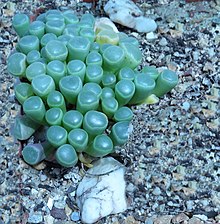
In the wild, the leaves of Fenestraria commonly are covered in soil, except for the transparent fenestration; this permits photosynthesis while reducing damage from exposure to intrense sunlight and herbivores.

Digitalis ferruginea owes its specific name to its ferruginous (rust-colored) flowers.

Calochortus fimbriatus has fimbriate flowers.


The pseudanthium of Zinnia elegans is typical of many Asteraceae in that it includes two types of florets, ray florets and disk florets.


Foveolate seeds of Physochlaina physaloides
G
[edit]- galbulus
- In gymnosperms, a fleshy cone (megastrobilus); chiefly relates to cones borne by junipers and cypresses, which are often mistakenly called berries.
- galea
- An overhanging, helmet-shaped, structure that protects the reproductive parts from precipitation, wind or unwanted visitors.
- gall
- Abnormal outgrowth on external plant tissues, caused by various parasites, from viruses, fungi and bacteria, to other plants, insects and mites.
- gamete
- A cell or nucleus that fuses with another of the opposite sex during sexual reproduction.
- gametophore
- Specialized structures on the gametophytes of some bryophyte species, for example many species in the order Marchantiales; in such species the gametes are produced on the gametophores.
- gametophyte
- The haploid multicellular phase in the alternation of generations of plants and algae that bears gametes. In bryophytes the gametophyte is the dominant vegetative phase; in ferns and their allies it is a small free-living plant known as the prothallus; in gymnosperms and angiosperms the gametophytes are reduced to microscopic structures dependent on the sporophyte, male gametophytes contained in pollen grains and females contained within the ovules.
- gamopetalous
- with joined or fused petals
- gamophyllous
- a single perianth-whorl of united segments. Compare symphyllous (synonym), apophyllous, and polyphyllous.
- gemma
- an asexual reproductive structure found in liverworts and mosses.
- gene pool
- The complete range of genetic variation found within a population.
- genus
A group of one or more species with features or ancestry (or both) in common. Genus is the principal category of taxa intermediate in rank between family and species in the standard nomenclatural hierarchy.
- generic name
- The name of a taxonomic genus, such as Acacia and Eucalyptus.
- genotype
- The genetic make-up of an individual.
- geophilous
- Growing or rooting in the ground.
- germination
- 1. of seeds, describing the complex sequence of physiological and structural changes that occur from resting to growth stage.
- 2. of a pollen grain; production of a pollen tube when contacting a stigma receptive to it.
- 3. of a spore of fungi/bacterium; change of state – from resting to vegetative.
- gibbous (gibbose)
- (of part of an organ) Swollen, usually with a pouch-like enlargement at the base.
- glabrescent
- Becoming glabrous, almost glabrous; glabrate.
- glabrous
- Lacking surface ornamentation such as hairs, scales or bristles; smooth.
- gland
- A secretory structure within or on the surface of a plant.
- glandular hair
- A hair tipped with a gland.
- glaucous
- Describing the external surface of a plant part that has a whitish covering, in some cases with a blueish cast. Often applied to plants with a wooly or arachnoid surface, but properly referring to pruinose surfaces, meaning those with a waxy bloom. The surfaces of the young leaves of many eucalypts provide good examples, and so do some xerophytes.
- globose
Roughly spherical. See also subglobose.
- globulose
- Approximately spherical.
- glochid
- A tiny barbed hair or bristle, e.g. the fine defensive hairs in cactus species such as Opuntia.
- glumes
- bracts subtending the floret(s) of a sedge, or similar plant; in grasses forming the lowermost organs of a spikelet (there are usually 2 but 1 is sometimes reduced; or rarely, both are absent).
- glutinous
- Sticky.
- graft
- 1. The artificial union of plant parts.
- 2. A plant shoot suitable for grafting; loosely, a scion, sucker, or branch.
- graft chimaera (sometimes graft hybrid)
- A taxon whose members consist of tissue from two or more different plants in intimate association originated by grafting. The addition sign "+" is used to indicate a graft-chimaera either as a part of a formula (e.g. Crataegus monogyna + Mespilus germanica) or in front of an abbreviated name (e.g. + Crataegomespilus 'Dardari'). The nomenclature of graft hybrids is governed by the International Code of Nomenclature for Cultivated Plants.
- graminaceous
Of or relating to grass.
- graminoid
- An herbaceous plant with a grass-like morphology.
- granular
- (of a surface) Covered with small rounded protuberances.
- grass
- A plant of the family Poaceae.
- grassland
- Low vegetation dominated by grasses.
- groundcover
- 1. Dense vegetation that covers the ground.
- 2. A term applied to describe a plant that covers the soil surface so densely that it smothers all beneath it.
- group
- A formal category equivalent to or below the rank of genus which distinguishes
- an assemblage of two or more cultivars within a species or hybrid;
- plants derived from a hybrid in which one or more of the parent species is not known or is of uncertain origin; or,
- a range of cultivated plants of a species or hybrid which may exhibit variation but share one or more characters, which makes it worth distinguishing them as a unit.
- guard cell
- Each of two cells surrounding the stoma which control gas exchange between the apoplast of the plant and the external environment.
- guttate
- Having droplet-shaped spots. Compare punctate and maculate.
- guttation
- The secretion of liquid water from uninjured plant parts. See hydathode.
- guttulate
- Having or appearing to be spotted with oil droplets; of spores, having oil droplets inside.
- gymnosperm
- A seed-bearing plant with unenclosed ovules borne on the surface of a sporophyll. Gymnosperms are among the oldest clades of vascular plants, and today are represented by approximately 1,000 extant species worldwide, including, among others, conifers, Ginkgo, Gnetum and cycads. Compare angiosperm.
- gynaecium
- Alternative term for gynoecium, but with partly different etymology.
- gynobasic
- Of a style, arising near the base of the gynoecium, e.g. between the lobes of the ovary.
- gynodioecious
- Of a species, with some plants bearing only bisexual flowers and others bearing only female flowers.
- gynomonoecious
- Of a species, with bisexual flowers and female flowers on the same plant.
- gynoecium
- The collective term for the female reproductive parts of a flower or for the carpels of a flower, whether united or free. Contrast androecium. Abbreviation: G. For instance, G indicates a superior ovary; G(5) indicates having five fused carpels.
- gynophore
- A stalk supporting the gynoecium and situated above the level of insertion of the other floral parts.
- gynostegium
- A compound organ in milkweeds (Asclepiadaceae) and orchids formed by fusion of the filaments of the stamens with the style. Also known as the column.


Gametophores (red male antheridia and brown female archegonia) borne on a gametophyte of a Chara species of green algae

Longitudinal section of immature male pine cone, showing male gametophytes (pollen grains) developing between the cone scales

Glandular hairs on the stem of Geranium dissectum

The leaves, buds, and young stalks of Eucalyptus macrocarpa are glaucous, covered with a thick waxy pruinosity.


Glumes of a grass species with a fairly large inflorescence
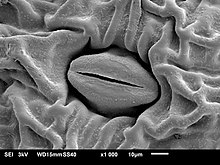
Scanning electron micrograph of a stoma on the leaf of Haemanthus. The two lip-shaped cells on either side of the pore are the guard cells.


Examples of gymnosperms
LEFT1-Welwitschia mirabilis
2-Cycas revoluta
3-Taxus baccata
4-Ginkgo biloba
RIGHT
1-Cupressus sempervirens
2-Sequoiadendron giganteum
3-Agathis dammara
4-Araucaria heterophylla
H
[edit]- habit
- The general external appearance of a plant, including size, shape, texture, and orientation.
- habitat
- The place where a plant lives; the environmental conditions of its home.
- hair
- A single elongated cell or row of cells borne on the surface of an organ.
- half-inferior ovary
- An ovary partly below and partly above the level of attachment of the other floral parts. Compare inferior ovary and superior ovary.
- halonate
- Having a transparent coating, or being of a spore's outer layer.
- halophyte
- A plant adapted to living in highly saline habitats; a plant that accumulates high concentrations of salt in its tissues.
- hand-pollination
- The controlled act of pollination that excludes the possibility of open-pollination.
- haploid
- Having one set of chromosomes, e.g. the complement of chromosomes in each of the cells of the gametophyte, the nucleus of a gamete, and the spores. This is expressed symbolically as n, where n = the gametic number of chromosomes. Compare diploid, triploid, and tetraploid.
- haplostemonous
- Having a single series of stamens equal in number to the proper number of petals, and alternating with them. Compare diplostemonous and obdiplostemonous.
- harmomegathy
- process by which pollen grains in arid environments close off their apertures to avoid losing water
- hastate
- Triangular in outline, the basal lobes pointing outward, so that the base appears truncate; may refer only to the base of a leaf with such lobes. Compare sagittate, which refers to basal lobes pointing backward.
- haustorium
- In parasitic plants, a structure developed for penetrating the host's tissues.
- head
- See capitulum, a pseudanthium.
- heathland
- Vegetation dominated by small shrubs which usually have ericoid leaves.
- helicoid
- Coiled; of a cymose inflorescence, when the branching is repeatedly on the same side (the apex is often recurved). Compare scorpioid.
- heliophilous
- Requiring or tolerating strong, direct sunlight.
- hemerochory
- A plant that has been transported voluntarily or involuntarily by humans in a territory which it could not have colonized by its own natural mechanisms of dissemination, or at least much more slowly.[34]
- hemi-legume
- A legume fruit in which the seed or seeds and one valve of the pod are dispersed as a unit. The valve catches the wind and blows away with the seeds, as in Acacia tenuifolia and Peltogyne paniculata.
- herb
- Any vascular plant that does not develop a woody stem at any point during its life cycle, e.g. a daffodil.
- herbaceous
- Not woody; usually green and soft in texture.
- herbarium
A collection of preserved, usually pressed and dried, plant material used for identification and comparison; also a building in which such collections are stored.
- hermaphrodite
- A synonym of bisexual.
- hesperidium
- A form of berry that occurs most familiarly in the genus Citrus. The fruit tends to be large for a berry, ranging from not much more than a centimeter in small fruited genera such as Murraya, to 15 cm or more in some varieties of Citrus. The outer rind typically is thick and tough with many oil glands, while the carpels within are packed with juicy fibers.
- heteroblastic
- Having parts, especially leaves, that are distinctly different between the juvenile and adult stages.
- heterophyllous
- Having more than one leaf type on the same plant. For example, leaves adapted to the open air and leaves adapted to being under water in Ranunculus aquatilis.[39]
- heterophylly
- A plant which is heterophyllous.[40]
- heteromorphic
- Having two or more distinct morphologies (e.g. of different size and shape). Compare isomorphic.
- heterospory
- The production of spores of two different sizes (small and large) by the sporophytes of land plants. Compare homospory.
- heterostyly
- The condition of a species having flowers with different style and stamen lengths, but with all the flowers of any one plant being identical. See distyly.
- hilum
- The scar on a seed coat where it separates from its stalk (funicle).
- hip
- The fruit of a rose plant.
- hippocrepiform
- Horseshoe-shaped.
- hirsute
- Bearing coarse, rough, longish hairs. See indumentum.
- hispid
- Bearing long, erect, rigid hairs or bristles, harsh to touch.
- hoary
- Covered with a greyish to whitish layer of very short, closely interwoven hairs, giving a frosted appearance.
- holotype
- A type chosen by the author of a name. Compare lectotype.
- homochlamydeous
- Having a perianth which is not divided into a separate calyx and corolla. Contrast dichlamydeous.
- homospory
- The production of spores of only one size by the sporophytes of land plants. Compare heterospory.
- hort.
Of gardens, an author citation used in two ways:
1. as a name misapplied by gardeners- 2. as an invalid name derived from horticultural writings of confused authorship.
- husk
- Protective outer covering of certain seeds, for example, the leafy outer covering of an ear of maize (corn), the leathery covering of the walnut, or the spiky covering of the chestnut.
- hyaline
- Translucent; usually delicately membranous and colorless.
- hybrid
- Plant produced by the crossing of parents belonging to two different named groups, e.g. genera, species, varieties, subspecies, forma and so on; i.e. the progeny resulting within and between two different plants. An F1 hybrid is the primary product of such a cross. An F2 hybrid is a plant arising from a cross between two F1 hybrids (or from the self-pollination of an F1 hybrid).
- hybrid formula
- The names of the parents of a hybrid joined by a multiplication sign, e.g. Cytisus ardonoi × C. purgans.
- hydrophily
- Form of pollination whereby pollen is distributed by the flow of waters.
- hypanthium
- Tube or cup-like structure in a flower that includes the bases of sepals, petals, and stamens, and may or may not be connected (adnate) to the ovary.
- hyper-resupinate
- In botany, describing leaves or flowers that are in the usual position but are borne on a petiole or pedicel that is twisted 360 degrees. The term is used to describe organs, such as orchid flowers, that are usually resupinate. Compare resupinate.
- hypocarpium
- Enlarged fleshy structure that forms below the fruit from the receptacle or hypanthium.
- hypocotyl
- Of an embryo or seedling, the part of the plant axis below the cotyledon and node, but above the root. It marks the transition from root to stem development.
- hypocrateriform
- Salver-shaped. Synonym of salverform. From Greek kratḗrion: a vessel.
- hypogynous
- Borne below the ovary; used to describe floral parts inserted below the ovary's level of insertion. Compare epigynous and perigynous.
- hysteranthous
- Type of growth in which new leaves appear after flowering. Also spelled histeranthous. Compare proteranthous and synanthous.

Epidermal hairs on plant leaves

Multicellular hairs on the edge of a sepal of Veronica sublobata
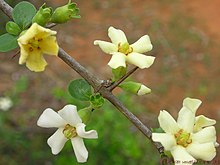

Markedly hastate leaf of Salvia canariensis

The swollen haustorium of Viscum capense renders the end of the branch stunted compared to the lower part of the branch.

The fruit of Poncirus is a typical hesperidium.

Heteroblastic growth is common in Eucalyptus species with leaves that are isobilateral in the mature tree; they generally start life with dorsiventral leaves. Some of these saplings are in the transient stage in which they have both forms of leaves, dorsiventral on lower branches, and isobilateral above.


A hypocarpium forms below the fruits of Sassafras albidum.

Flowers, fruit and propagule of a Rhizophora "mangle" or mangrove. The apparent root of the propagule is in fact meristematic tissue developing from the hypocotyl. The new plant develops largely from this tissue, especially if it has successfully penetrated into mud in which the new plant can establish itself.
I
[edit]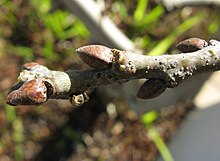

Petals of Mespilus germanica are imbricate before the flower opens.

Doubly imparipinnate compound leaf of Melia azedarach

Deeply incised leaves of Pelargonium graveolens

Indefinite stamens of Hypericum



 French
French Deutsch
Deutsch